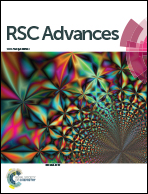Improved percutaneous delivery of azelaic acid employing microemulsion as nanocarrier: formulation optimization, in vitro and in vivo evaluation
Abstract
The present study aimed to develop and optimize a microemulsion (ME) nanocarrier system as a topical vehicle for azelaic acid (AZA) to improve its skin location and therapeutic efficacy. A D-optimal mixture experimental design was utilized to optimize ME for realizing maximum skin retention and appropriate droplet size. Three formulation variables, Smix X1 (a mixture of Span 20/ethanol, 1 : 9, w/w), water X2 and Oil X3 (Capryol 90), were included in the design, while the three responses were skin retention (Y1), amount of AZA in collection medium after 24 h (Y2) and mean particle size (Y3). The values of the formulation components (X1, X2 and X3) were 50.3%, 13.5% and 36.2%, respectively. In in vitro studies, the optimal ME revealed a much higher release rate, and enhanced skin targeting and penetration effects of AZA relative to control formulations (ethanol solution based gel and commercial cream). An attenuated total reflectance Fourier-transform infrared spectroscopy study further confirmed to us that the vehicles could transport the active agents across the stratum corneum (SC) layer by changing the amount and arrangement of lipid within the SC. In addition, a skin irritation test and pharmacodynamics studies were conducted, and the results suggested that the optimal ME exhibited a prominent therapeutic effect compared to control formulations, without any irritant response.


 Please wait while we load your content...
Please wait while we load your content...